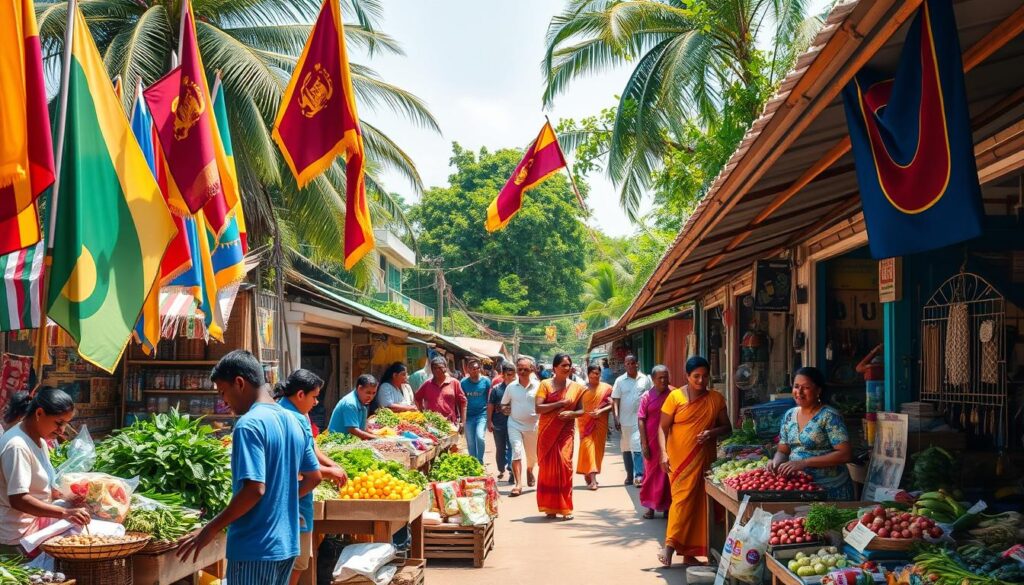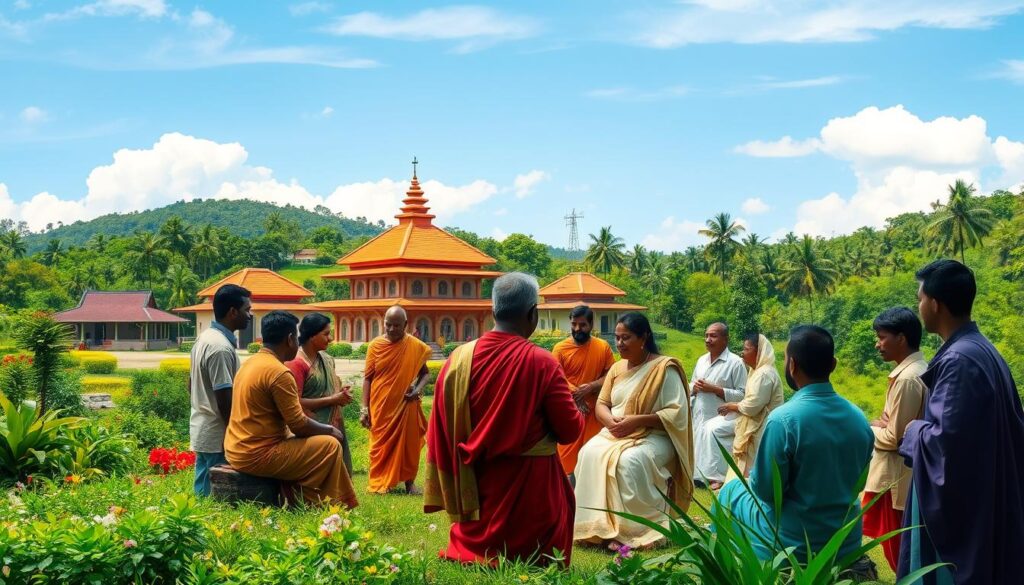Sri Lanka: Inflation Drops to Single Digits by Mid-2024
Sri Lanka’s economy is bouncing back after the 2022 economic crisis. Inflation has dropped from 69.8% in September 2022 to single digits by mid-2023. This shows a positive change in the country’s finances.
Smart money policies and reforms have helped stabilize the exchange rate. The IMF program has also supported the economic recovery. As a result, the economy grew in the last two quarters of 2023.

Official reserves increased to US$3.0 billion by the end of 2023. This is a big jump from US$500 million at the end of 2022. The Sri Lankan rupee also gained 10.8% in value during 2023.
The economy is stabilizing faster than expected. This has improved the short-term growth outlook. Experts now predict 4.4% growth in 2024.
These trends show the Sri Lankan economy’s strength. They also prove that government and central bank measures are working well.
Sri Lanka’s Economic Crisis and Inflation Peak in 2022
Sri Lanka faced a severe economic crisis in 2022. The country defaulted on its debt due to unsustainable levels and depleted reserves. Multiple factors caused this crisis, including poor economic management and structural weaknesses.
The economy shrank by 7.8% in 2022 and 7.9% in early 2023. Tourism, a key industry, collapsed during the crisis. This led to widespread job losses and shortages of essential goods.
The country experienced power cuts lasting up to 15 hours daily. This further strained the already struggling economy and affected daily life.
Factors Contributing to the Economic Crisis
Several factors contributed to Sri Lanka’s economic crisis, including:
- Macroeconomic mismanagement
- Long-standing structural weaknesses
- Exogenous shocks
- Unsustainable debt levels
- Depleted reserves

The Ceylon Electricity Board and Petroleum Corporation faced huge losses. They needed government help and loans from state banks to survive. The government had to support state banks with increased tax revenue.
Inflation Reaching Record Highs in 2022
Inflation in Sri Lanka peaked at 69.8% in September 2022. This caused the rupee to lose 81.2% of its value against the US dollar. Household budgets suffered due to tax hikes, price increases, and income losses.
Real wages fell by 16.9% in the private sector between 2021 and 2024. In the public sector, they dropped by 22% during the same period.
| Year | Inflation Rate | Currency Depreciation |
|---|---|---|
| 2022 | 69.8% | 81.2% |
| 2023 (August) | 4% | 11% appreciation |
Rising fuel and electricity prices hurt households. Higher taxes affected individuals and businesses, increasing production costs. The government suspended imports to stabilize the economy. However, key sectors still lacked cost-reflective pricing.
Government Reforms and Policy Adjustments
Sri Lanka’s government has taken action to stabilize the economy amid a severe crisis. They’ve implemented reforms focusing on fiscal consolidation, revenue measures, and expenditure control. These efforts aim to set the stage for economic recovery.
Key measures include prudent monetary policy, domestic debt restructuring, and structural reforms. The government has also prioritized revenue measures to address the country’s fiscal challenges.
Fiscal Consolidation Measures
The budget deficit grew from Rs. 1,244 billion to Rs. 1,614 billion from January to September. To address this, the government introduced cost-reflective utility pricing and new revenue measures.
These efforts have shown positive results. Total revenue increased from Rs. 1,448 billion to Rs. 2,110 billion in the same period.
Monetary Policy Stance and Interest Rates
The Central Bank of Sri Lanka has adopted a prudent monetary policy. The Standing Deposit Facility Rate decreased from 14.50% to 10.00% by October’s end.
These adjustments have helped moderate inflation. The Consumer Price Index dropped from 66.0% in 2022 to 1.5% in 2023.
The commercial bank average weighted new lending rate was 12.67% at April’s end. This indicates a gradual transmission of monetary policy changes.
Structural Reforms in Key Sectors
The government has started reforms to boost long-term growth and resilience. These focus on improving the business environment and strengthening the financial sector.
Infrastructure development is also a key area of investment. The IMF’s $2.9 billion bailout package has been crucial in supporting these reforms.
| Indicator | 2022 | 2023 |
|---|---|---|
| Inflation (Point to Point) – Consumer Price Index (2013=100) | 66.0% | 1.5% |
| Unemployment Rate | 4.6% (Q2) | 5.2% (Q2) |
| Budget Deficit (Jan-Sep) | Rs. 1,244 billion | Rs. 1,614 billion |
| Total Revenue (Jan-Sep) | Rs. 1,448 billion | Rs. 2,110 billion |
Inflation Drops to Single Digits by Mid-2024 After Peaking in 2022
Sri Lanka’s inflation rate has steadily declined since its record highs in 2022. By mid-2024, it dropped to single digits. This decrease is due to government reforms, monetary policy changes, and improved supply conditions.
The World Bank projects Sri Lanka’s economy to grow by 4.4% in 2024. This growth is expected to be driven by industrial and tourism sectors.
Gradual Decline in Inflation Rates
Headline inflation in Sri Lanka stayed low throughout 2024. This was helped by price adjustments and currency appreciation. Overall PCE inflation was 2.3% year-over-year in August 2024.
Core PCE inflation stood at 2.7%. CPI inflation data showed 2.6% growth in August 2024. This was a big drop from the 8.9% peak in 2022.
Factors Contributing to the Moderation of Inflation
Several factors have helped moderate inflation in Sri Lanka. Improved supply conditions have greatly impacted inflation outcomes. Weak private consumption has also kept inflation in check.
Currency appreciation has played a role in reducing inflationary pressures. Household disposable incomes remained low, contributing to subdued demand.
| Inflation Measure | August 2024 | Peak (Year) |
|---|---|---|
| Overall PCE | 2.3% | 6.5% (2022) |
| Core PCE | 2.7% | 3.7% (2023) |
| CPI | 2.6% | 8.9% (Peak) |
| Housing | 5.4% | – |
| Core (ex-housing) | 2.1% | – |
Impact on Cost of Living and Consumer Spending
The drop in inflation rates has positively affected Sri Lanka’s cost of living. As prices stabilize, households should see improved purchasing power. However, private consumption recovery is likely to be slow.
Disposable incomes are still affected by the economic crisis. The government’s ongoing reforms and efforts to attract foreign investment should support growth.
These measures are expected to improve living standards in the coming years. Economic growth and stability remain key goals for Sri Lanka’s future.
Conclusion
Sri Lanka’s economic recovery depends on implementing crucial policies. Recent progress is encouraging, but the country’s stability remains fragile. Limited buffers leave Sri Lanka vulnerable to risks like insufficient debt restructuring and policy uncertainty.
The government can boost the economy by implementing comprehensive structural reforms. These should focus on fiscal management, financial sector, and social assistance. Reforms in state-owned enterprises and trade can also help attract investment.
Policymakers must balance short-term measures with long-term changes. Building resilience through robust buffers is crucial. This can help Sri Lanka withstand future shocks and create a more stable economy.
By addressing these issues, Sri Lanka can increase investor confidence. This can lead to fresh capital inflows and sustainable growth. Ultimately, these efforts can help reduce poverty in the medium term.




